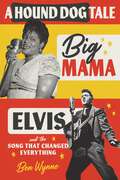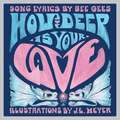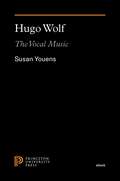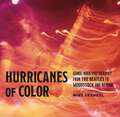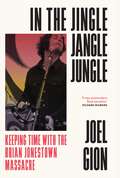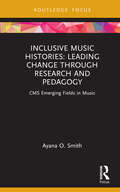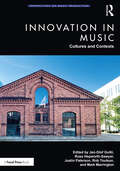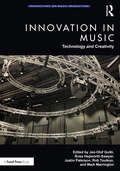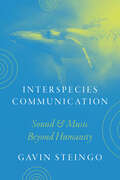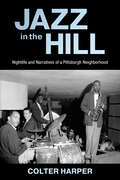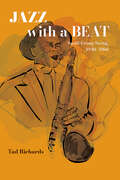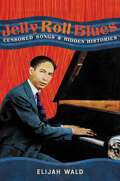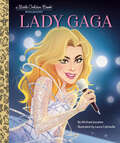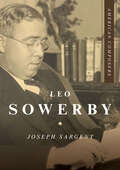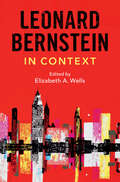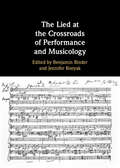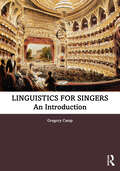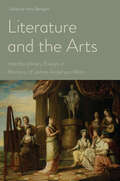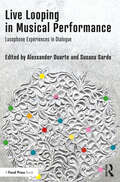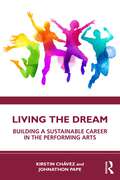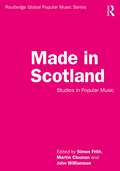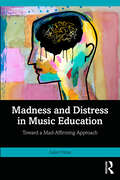- Table View
- List View
A Hound Dog Tale: Big Mama, Elvis, and the Song That Changed Everything
by Ben WynneThe release of the song “Hound Dog” in 1953 marked a turning point in American popular culture, and throughout its history, the hit ballad bridged divides of race, gender, and generational conflict. Ben Wynne’s A Hound Dog Tale discusses the stars who made this rock ’n’ roll standard famous, from Willie Mae “Big Mama” Thornton to Elvis Presley, along with an eclectic cast of characters, including singers, songwriters, musicians, record producers and managers, famous television hosts, several lawyers, and even a gangster or two.Wynne’s examination of this American classic reveals how “Hound Dog” reflected the values and issues of 1950s American society, and sheds light on the lesser-known elements of the song’s creation and legacy. A Hound Dog Tale will capture the imagination of anyone who has ever tapped a foot to the growl of a blues riff or the bark of a rock ’n’ roll guitar.
How Deep Is Your Love: A Children's Picture Book
by Bee GeesA majestic picture book based on the Bee Gees's classic love song "How deep is your love? I really mean to learn 'Cause we're living in a world of fools Breaking us down When they all should let us be We belong to you and me . . ." How Deep Is Your Love is a fantastical picture book based on one of the Bee Gees's biggest hits. The song topped the Billboard Hot 100 chart, remaining in the top ten for seventeen weeks, and won the band's first of eight GRAMMY awards. With lyrics by the Bee Gees and illustrations by J.L. Meyer, the picture book tells the tale of two bunny mermaids who meet on a rock and descend into the water together. As the bunnies escape traps, skirt around nets and hooks, and protect each other in this thrilling adventure, they realize how deep their love is. Meyer's imaginative story compliments the hit song perfectly and will delight children and adults alike.
Hugo Wolf: The Vocal Music
by Susan YouensA groundbreaking look at one of the great song composers of the late Romantic periodIn the virtual cottage industry of works on fin de siècle Vienna, Hugo Wolf (1860–1903) has been somewhat neglected, perhaps because he was the master of a small genre—the late Romantic lied—and never truly made his mark in the larger forms that command greater public attention. But in the realm of song, he is among the greatest inheritors of Schubert and Schumann, one who was both a traditionalist and a modernist. When the Viennese critic Eduard Hanslick disapprovingly dubbed Wolf &“the Richard Wagner of the lied,&” he was paying oblique homage to Wolf&’s genius as a song composer in the most modern manner.In this book, Susan Youens examines five aspects of Wolf&’s compositional art, each exemplifying a different synthesis of traditionalism and modernity and spanning his entire, tragically brief creative life, from his first efforts to his lapse into insanity in 1897. She discusses Wolf&’s youthful imitations of Schumann, his genius for comic songs of a kind unlike any of his predecessors, his part in the ballad revival of the late nineteenth century, Wolf in relation to his contemporaries, and his pursuit of operatic fame. Youens looks as closely at the poetic texts as she does the music and includes numerous previously unpublished sketches and fragments, examples from songs now long out of print and difficult to obtain, and citations from Wolf&’s vivid letters and other sources of the period.
Hurricanes of Color: Iconic Rock Photography from the Beatles to Woodstock and Beyond (American Music History)
by Mike FrankelIn 1964, fifteen-year-old Mike Frankel found himself among professional photojournalists covering a Beatles concert during the band’s first tour in the United States. A few years later, he was a regular photographer at the Fillmore East, a storied venue in classic rock. And in 1969, he was onstage at Woodstock, documenting one of the most important events in American music history.Featuring Frankel’s stunning photographs of nearly every major rock figure from the 1960s and ’70s—including Led Zeppelin, Pink Floyd, the Rolling Stones, Janis Joplin, and the Grateful Dead—as well as many unpublished images of the Beatles, Hurricanes of Color chronicles an extraordinary moment. Frankel, who was for a time a personal photographer for Jefferson Airplane and Hot Tuna, developed an innovative style—one that layered images with multiple exposures to capture the spirit of the music of the era and the experience of listening to the bands live.A must-have for fans of classic rock, this is a spectacular and profound collection of photography that complements the music of the world’s biggest performers.
In the Jingle Jangle Jungle: Keeping Time with the Brian Jonestown Massacre
by Joel GionThe Brian Jonestown Massacre are one of the great contemporary cult American rock and roll bands. At the peak of their anarchic reign in the San Francisco underground of the mid '90s their psychedelic output was almost as prodigious and impressive as their narcotic intake. Immortalised in one of the most unforgettable rock and roll documentaries of all time, DIG! alongside their friends/rivals/nemeses, The Dandy Warhol's, in their early years when the US were obsessed with grunge, the BJM felt like a '60s anachronism. But with albums like Their Satanic Majesties Second Request and Thank God for Mental Illness, and incendiary, often chaotic, live shows, they burnished their legend as true believers and custodians of the original west coast flame; a privilege and responsibility which continues to this day when the band have a bigger and more dedicated audience than ever.Joel Gion's memoir tells the story of the first ten years of the band from the Duke Seat. A righteous account of the hazards and pleasures of life on and off the road, In the Jingle Jangle Jungle takes use behind the scenes of the supposed behind the scenes film that cemented the band's legend. Funny as hell, shot through with the innocence and wonder of a 'percussionist' whose true role is that of the band's 'spirit animal', In the Jingle Jangle Jungle is destined to take its place alongside cult classics in the pantheon of rock and roll literature like Playing the Bass with Three Left Hands, Head On, and 45 by Bill Drummond. It will also feature a foreword by Anton Newcombe, fellow member and founder of The Brian Jonestown Massacre.
Inclusive Music Histories: CMS Emerging Fields in Music (CMS Emerging Fields in Music)
by Ayana O. SmithInclusive Music Histories: Leading Change through Research and Pedagogy models effective practices for researchers and instructors striving either to reform music history curricula at large or update individual topics within their classes to be more inclusive. Confronting racial and other imbalances of Western music history, the author develops four core principles that enable a shift in thinking to create a truly intersectional music history narrative and provides case studies that can be directly applied in the classroom. The book addresses inclusivity issues in the discipline of musicology by outlining imbalances encoded into the canonic repertory, pedagogy, and historiography of the field. This book offers comprehensive teaching tools that instructors can use at all stages of course design, from syllabus writing and lecture planning to discussion techniques, with assignments for each of the subject matter case studies. Inclusive Music Histories enables instructors to go beyond token representation to a more nuanced music history pedagogy.
Inclusive Music Histories: CMS Emerging Fields in Music (CMS Emerging Fields in Music)
by Ayana O. SmithInclusive Music Histories: Leading Change through Research and Pedagogy models effective practices for researchers and instructors striving either to reform music history curricula at large or update individual topics within their classes to be more inclusive. Confronting racial and other imbalances of Western music history, the author develops four core principles that enable a shift in thinking to create a truly intersectional music history narrative and provides case studies that can be directly applied in the classroom. The book addresses inclusivity issues in the discipline of musicology by outlining imbalances encoded into the canonic repertory, pedagogy, and historiography of the field. This book offers comprehensive teaching tools that instructors can use at all stages of course design, from syllabus writing and lecture planning to discussion techniques, with assignments for each of the subject matter case studies. Inclusive Music Histories enables instructors to go beyond token representation to a more nuanced music history pedagogy.
Innovation in Music: Cultures and Contexts (ISSN)
by Jan-Olof Gullö Russ Hepworth-Sawyer Justin Paterson Rob Toulson Mark MarringtonInnovation in Music: Cultures and Contexts is a groundbreaking collection bringing together contributions from instructors, researchers, and professionals. Split into two sections, covering creative production practices and national/international perspectives, this volume offers truly global outlooks on ever-evolving practices.Including chapters on Dolby Atmos, the history of distortion, creativity in the pandemic, and remote music collaboration, this is recommended reading for professionals, students, and researchers looking for global insights into the fields of music production, music business, and music technology.
Innovation in Music: Technology and Creativity (ISSN)
by Jan-Olof Gullö Russ Hepworth-Sawyer Justin Paterson Rob Toulson Mark MarringtonInnovation in Music: Technology and Creativity is a groundbreaking collection bringing together contributions from instructors, researchers, and professionals. Split into two sections, covering composition and performance, and technology and innovation, this volume offers truly international perspectives on ever-evolving practices.Including chapters on audience interaction, dynamic music methods, AI, and live electronic performances, this is recommended reading for professionals, students, and researchers looking for global insights into the fields of music production, music business, and music technology.
Interspecies Communication: Sound and Music beyond Humanity
by Gavin SteingoA surprising study reveals a plethora of attempts to communicate with non-humans in the modern era. In Interspecies Communication, music scholar Gavin Steingo examines significant cases of attempted communication beyond the human—cases in which the dualistic relationship of human to non-human is dramatically challenged. From singing whales to Sun Ra to searching for alien life, Steingo charts the many ways we have attempted to think about, and indeed to reach, beings that are very unlike ourselves. Steingo focuses on the second half of the twentieth century, when scientists developed new ways of listening to oceans and cosmic space—two realms previously inaccessible to the senses and to empirical investigation. As quintessential frontiers of the postwar period, the outer space of the cosmos and the inner space of oceans were conceptualized as parallel realities, laid bare by newly technologized “ears.” Deeply engaging, Interspecies Communication explores our attempts to cross the border between the human and non-human, to connect with non-humans in the depths of the oceans, the far reaches of the universe, or right under our own noses.
Jazz in the Hill: Nightlife and Narratives of a Pittsburgh Neighborhood (American Made Music Series)
by Colter HarperFrom the 1920s through the 1960s, Pittsburgh’s Hill District was the heart of the city’s Black cultural life and home to a vibrant jazz scene. In Jazz in the Hill: Nightlife and Narratives of a Pittsburgh Neighborhood, Colter Harper looks at how jazz shaped the neighborhood and created a way of life. Beyond backdrops for remarkable careers, jazz clubs sparked the development of a self-determined African American community. In delving into the history of entrepreneurialism, placemaking, labor organizing, and critical listening in the Hill District, Harper forges connections to larger political contexts, processes of urban development, and civil rights struggles.Harper adopts a broad approach in thinking about jazz clubs, foregrounding the network of patrons, business owners, and musicians who were actively invested in community building. Jazz in the Hill provides a valuable case study detailing the intersections of music, political and cultural history, public policy, labor, and law. The book addresses distinctive eras and issues of twentieth century American urban history, including notions of “vice” during the Prohibition Era (1920–1934); “blight” during the mid-twentieth century boom in urban redevelopment (1946–1973); and workplace integration during the civil rights era (1954–1968). Throughout, Harper demonstrates how the clubs, as a nexus of music, politics, economy, labor, and social relations, supported the livelihood of residents and artists while developing cultures of listening and learning. Though the neighborhood has undergone an extensive socioeconomic transformation that has muted its nightlife, this musical legacy continues to guide current development visions for the Hill on the cusp of its remaking.
Jazz with a Beat: Small Group Swing, 1940–1960 (Excelsior Editions)
by Tad RichardsJazz with a Beat is the first book on the often overlooked but vitally important genre of small group swing jazz. Coming into being in the early 1940s, small group swing answered the need in the Black community for a form of jazz that was more accessible (and more danceable) than the new bebop. An adaptation of the big band Black swing (Erskine Hawkins, Jimmie Lunceford, Chick Webb) of the 1930s to small combos, and with a more vigorous beat for the new generation, this music developed and was beloved through the 1940s, continued to be enjoyed through the rock and roll years of the 1950s, and was a major influence on the soul jazz of the 1960s. Among the many hit artists portrayed in these pages are Illinois Jacquet, Louis Jordan, Big Jay McNeely, Joe Liggins, Nat "King" Cole, Red Prysock, Ruth Brown, Nellie Lutcher, Camille Howard, T-Bone Walker, and Ray Charles. Dismissed as "rhythm and blues," this music has been ignored by jazz historians. Jazz with a Beat honors this music as a legitimate genre of jazz and is a stirring evocation of an era. It should be of interest to lovers of jazz and Americana.
Jelly Roll Blues: Censored Songs and Hidden Histories
by Elijah WaldA bestselling music historian follows Jelly Roll Morton on a journey through the hidden worlds and forbidden songs of early blues and jazz. In Jelly Roll Blues: Censored Songs and Hidden Histories, Elijah Wald takes readers on a journey into the hidden and censored world of early blues and jazz, guided by the legendary New Orleans pianist Jelly Roll Morton. Morton became nationally famous as a composer and bandleader in the 1920s, but got his start twenty years earlier, entertaining customers in the city&’s famous bordellos and singing rough blues in Gulf Coast honky-tonks. He recorded an oral history of that time in 1938, but the most distinctive songs were hidden away for over fifty years, because the language and themes were as wild and raunchy as anything in gangsta rap. Those songs inspired Wald to explore how much other history had been locked away and censored, and this book is the result of that quest. Full of previously unpublished lyrics and stories, it paints a new and surprising picture of the dawn of American popular music, when jazz and blues were still the private, after-hours music of the Black "sporting world." It gives new insight into familiar figures like Buddy Bolden and Louis Armstrong, and introduces forgotten characters like Ready Money, the New Orleans sex worker and pickpocket who ended up owning one of the largest Black hotels on the West Coast. Revelatory and fascinating, these songs and stories provide an alternate view of Black culture at the turn of the twentieth century, when a new generation was shaping lives their parents could not have imagined and art that transformed popular culture around the world—the birth of a joyous, angry, desperate, loving, and ferociously funny tradition that resurfaced in hip-hop and continues to inspire young artists in a new millennium.
John Zorn’s File Card Works: Hypertextual Intermediality in Composition and Analysis (ISSN)
by Maurice WindleburnThis book is the first study of John Zorn’s ‘file card’ works, with special focus made on the pieces Godard (1985), Spillane (1986), Interzone (2010), and Liber Novus (2010). It explains the unique creative process behind these compositions, contextualizing them in relation to the history of file cards, the ‘open work’ concept, cinematic listening, and uncreative aesthetics. Semiotic, hermeneutic, and ekphrastic analyses draw hypertextual links between the four file card compositions and the worlds of their respective dedicatees: author Mickey Spillane, filmmaker Jean-Luc Godard, novelist William S. Burroughs and painter Brion Gysin, and psychiatrist C. G. Jung.This book will appeal not only to those interested in Zorn’s music, but also to scholars of music semiotics and hermeneutics, intermedia studies, and avant-garde music.
Lady Gaga: A Little Golden Book Biography (Little Golden Book)
by Michael JoostenHelp your little one dream big with a Little Golden Book biography about pop music icon, actress, and philanthropist Lady Gaga. Little Golden Book biographies are the perfect introduction to nonfiction for young readers—as well as fans of all ages!This Little Golden Book about Lady Gaga--the genre-straddling singer of hits including "Born This Way" and "Shallow" and star of House of Gucci and A Star is Born--is an inspiring read-aloud for young children and their parents who are fans. Look for more Little Golden Book biographies: • Willie Nelson • Beyoncé • Dolly Parton • Taylor Swift • Tony Bennett
Leo Sowerby (American Composers)
by Joseph SargentFrom the 1920s to the 1940s, Leo Sowerby created popular secular works while his sacred compositions led admirers to call him the “dean of American church musicians.” Yet in time, Sowerby’s Pulitzer Prize-winning The Canticle of the Sun and the rest of his corpus lost favor with the A-list symphonies and prominent musicians who had once made him a fixture in their repertoires. Joseph Sargent’s biography offers the first focused study of Sowerby’s life and work against the backdrop of the composer’s place in American music. As Sargent shows, Sowerby’s present-day marginalization as a composer relates less to the quality of his work than the fact that today’s historiographical practices and canon-building activities minimize modern church music. Sargent’s re-evaluation draws on a wide range of perspectives and composer’s music and writings to enrich detailed analyses of musical works and a career-spanning consideration of Sowerby’s musical language and aesthetic priorities.
Leonard Bernstein in Context (Composers in Context)
by Elizabeth WellsDesigned for students, aficionados of classical music, and historians, this volume offers a wide-ranging, multi-disciplinary and comprehensive view of one of the most important musicians of the twentieth century at his 100th anniversary. Scholars from diverse backgrounds and fields have contributed rich insights into Bernstein's life and work in an approachable style, shedding light on Bernstein's social, professional and ideological contexts including his contemporaries and rivals on Broadway, his artistic collaborations, his celebrity status as a conductor on the international concert circuit, and his involvement in music education via broadcasting. From his early education, through his conducting and composing careers, to his fame as musical and cultural ambassador to the world, this book views Bernstein the man and the artist and provides a fascinating overview of American classical music culture during Bernstein's long career in the public spotlight.
Let Me Take You Down: Penny Lane and Strawberry Fields Forever
by Jonathan CottThe conception, creation, recording, and significance of the Beatles&’ &“Penny Lane&” and &“Strawberry Fields Forever&” John Lennon wrote &“Strawberry Fields Forever&” in Almería, Spain, in fall 1966, and in November, in response to that song, Paul McCartney wrote &“Penny Lane&” at his home in London. A culmination of what was one of the most life-altering and chaotic years in the Beatles&’ career, these two songs composed the 1967 double A-side 45 rpm record that has often been called the greatest single in the history of popular music and was, according to Beatles producer George Martin, &“the best record we ever made.&” In Let Me Take You Down: Penny Lane and Strawberry Fields Forever, Jonathan Cott recounts the conception and creation of these songs; describes the tumultuous events and experiences that led the Beatles to call it quits as a touring band and redefine themselves solely as recording artists; and details the complex, seventy-hour recording process that produced seven minutes of indelible music. In writing about these songs, he also focuses on them as inspired artistic expressions of two unique ways of experiencing and being in the world, as Lennon takes us down to Strawberry Fields and McCartney takes us back to Penny Lane. In order to gain new vistas and multiple perspectives on these multifaceted songs, Cott also engages in conversation with five remarkable people: media artist Laurie Anderson; guitarist Bill Frisell; actor Richard Gere; Jungian analyst Margaret Klenck; and urban planner, writer, and musician Jonathan F. P. Rose. The result is a wide-ranging, illuminating exploration of the musical, literary, psychological, cultural, and spiritual aspects of two of the most acclaimed songs in rock and roll history.
The Lied at the Crossroads of Performance and Musicology
by Benjamin Binder Jennifer RonyakThere seems to be an essential relationship between the performance and the scholarship of the German Lied. Yet the process by which scholarly inquiry and performative practices mutually benefit one another can appear mysterious and undefined, in part because any dialogue between the two invariably unfolds in relatively informal environments – such as the rehearsal studio, seminar room or conference workshop. Contributions from leading musicologists and prominent Lied performers here build on and deepen these interactions to reconsider topics including Werktreue aesthetics and concert practices; the authority of the composer versus the performer; the value of lesser-known, incomplete, or compositionally modified songs; and the traditions, habits and prejudices of song recitalists regarding issues like transposition, programming and dramatic modes of presentation. The book as a whole reveals the reciprocal relevance of Lied musicology and Lied performance, thereby opening doors to fresh and exciting modes of interpretative artistry and intellectual discovery.
Linguistics for Singers: An Introduction
by Gregory CampLinguistics for Singers: An Introduction is a textbook and manual that provides singers with a foundation in linguistic features of four major singing languages—English, Italian, French, and German—and shows how these features can be used to inform vocal performance and interpretation. Going beyond the basics of lyric diction, a grounding in linguistics enables student musicians to understand language holistically and more fully comprehend the music they are learning. The comparative approach to four common languages allows readers to readily grasp similarities and apply principles across vocal repertoire. Beginning with the sounds of a language and gradually moving up through larger levels of linguistic structure, from words to full texts, the chapters illustrate concepts using real examples from art songs and opera. The clear explanations enable readers new to linguistics to connect these concepts with their own musical practice. Designed for flexible use in courses on language and singing, lyric diction, repertoire studies, and collaborative piano, this book provides a vital resource for singers, vocal instructors, and conductors.
Literature and the Arts: Interdisciplinary Essays in Memory of James Anderson Winn
by Anna Battigelli Steven N Zwicker Amanda Eubanks Winkler Paul Hammond Andrew Walkling David Hopkins Cedric D Reverand Paula R. Backscheider Ellen T Harris Peter Sabor Melissa A SchoenbergerThe ten essays in Literature and the Arts explore the intermedial plenitude of eighteenth-century English culture, honoring the memory of James Anderson Winn, whose work demonstrated how seeing that interplay of the arts and literature was essential to a full understanding of Restoration and eighteenth-century English culture. Scenery, machinery, music, dance, and texts transformed one another, both enriching and complicating generic distinctions. Artists were alive to the power of the arts to reflect and shape reality, and their audience was quick to turn to the arts as performative pleasures and critical lenses through which to understand a changing world. This collection's eminent authors discuss estate design, musicalized theater, the visual spectacle of musical performance, stage machinery and set designs, the social uses of painting and singing, drama’s reflection of a transformed military infrastructure, and the arts of memory and of laughter.
Live Looping in Musical Performance: Lusophone Experiences in Dialogue
by Alexsander Duarte Susana SardoLive Looping in Musical Performance offers a diverse range of interdisciplinary perspectives on the application of live looping technology by lusophone performers and composers. This book explores various aspects, including the aesthetic component, instrumentation, and setup, highlighting the versatility of this technology in music-making. Written by musicians and researchers from Portuguese-speaking countries, this book comprises eleven chapters that delve into various musical contexts, genres, and practices. The novelty of including collaborative texts written alongside non-professional researchers offers the possibility of drawing from real experience to consider how live looping has been changing and "cyborguising" the concept of music, the ritual of the performance, the identity of the musicians, and the public's expectations. Live Looping in Musical Performance provides cutting-edge reading for composers and performers, as well as ethnomusicologists, students, and researchers working in the areas of music production, technology, and performance. This book addresses a broader audience, both academic and non-academic, who are interested in new processes of musical creativity in a post-human world.
Living the Dream: Building a Sustainable Career in the Performing Arts
by Kirstin Chávez Johnathon PapeLiving the Dream: Building a Sustainable Career in the Performing Arts offers an accessible guide to understanding one’s arts career as a business. This essential companion to the inner workings of the arts world begins with defining the dream, including how to conceive mission statements, branding and business plans. Part II covers sharing the dream with others through social media, networking, and working with agents or artist managers. Part III offers an overview of the financial aspect, including budgets, taxes, and managing risks. Part IV concludes by discussing the realities of an arts career, including work/life balance, preparing for the future, and managing mental health. This practical and insightful overview is a must‑have companion for aspiring and early career professionals in the performing arts, as well as students on a range of arts courses, including Music Business, Entrepreneurship, and Career Skills classes.
Made in Scotland: Studies in Popular Music (Routledge Global Popular Music Series)
by Simon Frith Martin Cloonan John WilliamsonMade in Scotland: Studies in Popular Music serves as a comprehensive and thorough introduction to the history, politics, culture, and musicology of twentieth- and twenty-first-century popular music in Scotland. The volume consists of essays by local experts and leading scholars in Scottish music and culture, and covers the major figures, styles, and social contexts of popular music in Scotland. Each essay provides adequate context so readers understand why the figure or genre under discussion is of lasting significance. The book includes a general introduction to Scottish popular music, followed by essays organized into three thematic sections: Histories, Politics and Policies, and Futures and Imaginings. Examining music as cultural expression in a country that is both a nation and a region within a larger state, this volume uses popular music to analyse Scottishness, independence, and diversity and offers new insights into the complexity of cultural identity, the power of historical imagination, and the effects of power structures in music. It is a vital read for scholars and students interested in how popular music interacts with and shapes such issues both within and beyond the borders of Scotland.
Madness and Distress in Music Education: Toward a Mad-Affirming Approach
by Juliet HessMadness and Distress in Music Education offers an in-depth exploration of mental health and emotional distress in the context of music education, offering new ways of thinking about these experiences and constructing ways to support distress through affirming pedagogy, practices, and policies in music education. Centering the lived experiences of 15 people in a range of roles across music education who self-identify an issue with their mental health, the volume addresses impacts on both students and educators. The author draws on Mad Studies and disability studies to present new paradigms for thinking about Madness and distress in the music context. An essential resource for music educators, music education researchers, and preservice students seeking to understand the complexities of mental health in the music classroom, this book considers how people conceptualize their mental health, how distress impacts participation in music education, how music education may support or exacerbate distress, and what supports for distress can be implemented in music education.
